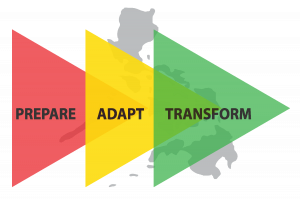By Amb. Roberto R. Romulo
As I read this definition, I conclude that the mayors should be the first to prepare and respond to disasters. They are the front line and that is why every city has a Disaster Risk Reduction Management Council (DRRMC). They are fully aware that the Philippines is the third most disaster-prone country among 173 countries, only behind Vanuatu and Tonga.
A recent announcement indicated that there has been a risk assessment of the locations in the West Valley Fault by the City of Makati. This is part of the Mayor’s program. It is to the credit of Mayor Abby Binay that she has had the guts to tell residents in danger zones to leave in order to minimize loss of lives and property in case of a strong earthquake. She said that those who leave will receive financial aid for their relocation.
“We will not expropriate. The city will not buy your property; we will just provide help. If you decline our offer, you have to sign a waiver that you are accepting the risks.” Bravo!!! I hope others will demonstrate the same intestinal fortitude.
In view of the country’s continuing exposure and vulnerability to natural hazards, the Carlos P. Romulo Foundation in collaboration with the Zuellig Family Foundation, the Manila Observatory (of Ateneo), and the Philippine Disaster Resilience Foundation will conclude their three-year program to promote multisectoral dialogue and cooperation on building the country’s resilience to natural disasters by holding a conference entitled “Building a Disaster Resilient Philippines” on April 25 and 26. We are pleased to announce that ARISE Philippines has recently joined us in this initiative.
Drawing on the presentations and discussions, the conference will seek to identify the gaps in current disaster preparedness, prevention, response and recovery plans both within the public and private sectors and between them. More importantly, it will draw up proposed measures — action programs and protocols, legislative and regulatory changes, and possibly, a multi-stakeholder institutional framework to promote continuing cooperation, dialogue and information exchange among the key sectors of Philippine society — with a view to strengthening the country’s disaster resilience.
DND Secretary Delfin Lorenzana will be the keynote speaker. During the first session we have invited foreign experts to discuss lessons learned and best practices in disaster resilience. Dr. Wei Sen Li will cover the experience of Chinese Taipei. Dr. Satoru Nishikawa will discuss the Tohoku earthquake and tsunami of 2011. Dr. Rajib Shaw (thru video) will present the Sendai Framework DRR and resilience. The concluding speaker will be Admiral Pama, formerly NDRRMC Executive Director and OCD Administrator. He will discuss how to incorporate lessons learned into the local disaster risk reduction and management framework.
We will ask each of the speakers to identify the gaps in their own topics and issues and to pinpoint potential action points and legislative proposals, if any.
The three other sessions will focus on enhancing risk reduction measures, disaster resilience in key sectors notably infrastructure, health and initiatives of LGUs and last but not the least, how to incorporate disaster resilience into development planning and policy. For this last session, we will present a summary of proposed legislative input to selected legislators from the Senate and House of Representatives and ask them to comment on the proposals.
In sum, we believe that building disaster resilience means one has to go beyond disaster response.
Revisiting Role of NDRRMC
I have been informed that there has been a multiple agency task force that has produced a draft bill amending RA No. 10121. Quoting from their draft bill: “While RA 10121’s strength lies in its institutionalization of stakeholder participation in policymaking for disaster risk reduction and management, through an expanded membership of the Council, and while this, in itself, is a development by leaps and bounds, RA 10121’s shortcoming is its failure to create an institution that is in a sufficiently high position to oversee the implementation of streamlined disaster risk reduction and management policies nationwide, an institution that has the necessary authority, mandate and resources to lead and coordinate the efforts of different stakeholders towards a more resilient nation. The occurrence of Typhoon Yolanda and other large-scale disasters revealed that problems encountered in coordinating and implementing large-scale disaster risk reduction and management efforts are rooted primarily in the nature of our governance framework for disaster risk reduction and management.”
The proposed amendments will be discussed during our conference and I will not dwell into the details at this time. Suffice it to say that it is movement in the right direction. Hopefully, the conference will be able to provide further input, particularly from the private sector perspective.
As previously stated above, we must go beyond disaster response. I hope that thought will be embedded in the new legislation.
My gratitude and admiration for Undersecretary Toby Purisima of OCD who has managed the development process.
SOURCE:
Romulo, R. (2017, March 31). Building a disaster resilient Phl, Filipino Worldview. Retrieved from https://www.pressreader.com/philippines/the-philippine-star/20170331/282136406250641
![]()


